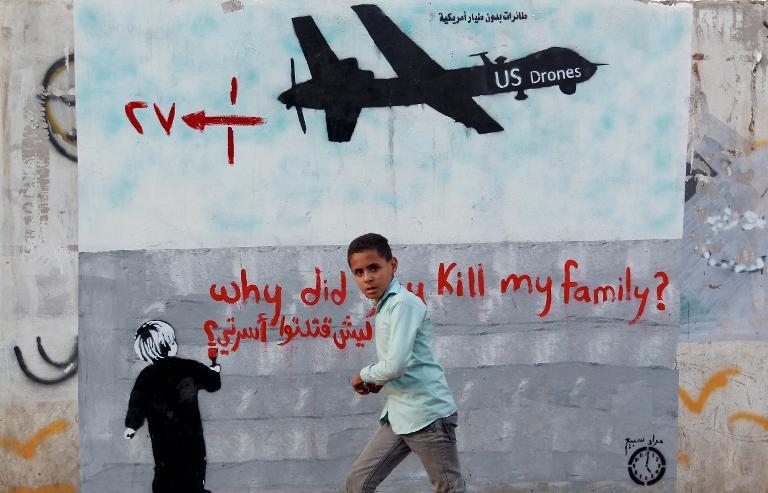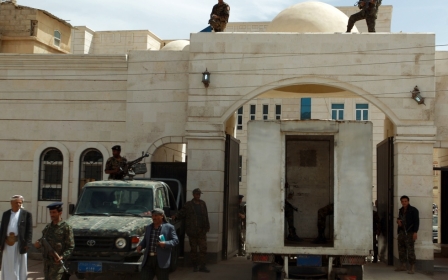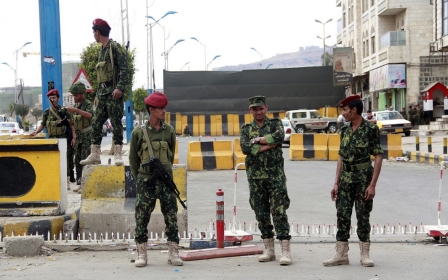Yemen becomes front line in US drone war

Ebad al-Shabwani was driving his vehicle late one evening last month along the road between Safir and the ancient ruins of Mahram Bilqis in the remote Wadi Abeeda area of Yemen’s central Marib district. His family claims he was, at 16 years old, the youngest in a ride he was sharing with friends.
Precisely what happened next is unclear. What is known is that, out of the darkness, a United States armed drone appeared in the vicinity. It had most likely taken off hours earlier from the US Expeditionary Naval Base at Camp Lemonnier in Djibouti, across the Gulf of Aden, and had located its target. The drone fired on the vehicle with between one and three Hellfire missiles, scoring a direct hit. Shabwani and as many as three others were killed.
The incident was part of a recent uptick in covert US operations inside Yemen, and one of six US drone strikes in the country within the space of 11 days. According to data gathered by the London-based Bureau of Investigative Journalism, there have been as many as 14 drone strikes in Yemen in 2014 alone, out of a minimum of 62 total since 2002. At least 302 people have been killed in these operations (upper estimates put the death toll at more than 500).
New front line
On Saturday, a US drone struck two cars on a highway between the towns of Sawmaa and and Al-Bayda in Yemen’s south east, killing at least nine and as many as 21 people. Yemeni officials said that the strike had killed nine suspected al-Qaeda in the Arabian Peninsula (AQAP) militants while admitting that the attack had "inadvertently killed and wounded some civilians". Survivor Salem Naser al-Khashem told local media that the strike had killed three labourers and that least one drone fired repeatedly on the site of the original hit.
On Sunday, as many as five people were killed in a suspected drone strike on a remote mountainous region of Abyan province. Government and defence ministry officials declared the strike had hit AQAP training facilities, taking out two of the group’s local commanders.
What is remarkable about drone strikes in Yemen is not their reported regularity in 2014, but that they are still happening at all. In five years under Barack Obama’s leadership the United States has carried out more than 390 drone strikes in Pakistan, Yemen and Somalia, killing more than 2,400 people. At least 273 of them were reportedly civilians. The New York Times, in a story about Washington’s secret “kill list” of targets of drone strikes, reported that Obama “signs off on every strike in Yemen and Somalia and also on the more complex and risky strikes in Pakistan.”
At the height of Obama’s drone programme in Pakistan, in 2010, the CIA and Joint Special Operations Command (JSOC) drones were carrying out strikes at a rate of more than two a week in the country’s lawless tribal belt.
But US drone operations in Pakistan have seen a steep decline in the past 18 months. The last drone strike there was on Christmas Day 2013 and the current hiatus in targeted killings in Pakistan is by far the longest under Obama. Officials party to negotiations between the Taliban (TTP) and the Pakistani government put this current lull down to a tacit agreement in Washington and Islamabad that all strikes - save those aimed at high-value targets - be shelved while peace talks continue. 2013 was the first year that there was not a single confirmed civilian casualty from drone strikes in Pakistan. Even so, the US has launched drone strikes which have killed off TTP-Islamabad talks on at least four occasions since the start of 2013, and is reportedly tracking an American citizen in Pakistan it expects to target with Hellfires should the opportunity present itself.
The contrast with Yemen is marked. The 14 possible drone strikes in the first quarter of 2014, if confirmed, would represent the highest concentration of drone activity in Yemen since May 2012, when as many as 53 strikes took place during the second quarter of the year. Overwhelmingly, local and international media - often citing security or military sources - report that the victims are suspected members of AQAP (as has happened this weekend) and by implication fair game for assassination by drone.
Radicalised Yemenis
Multiple outlets reported Ebad al-Shabwani belonged to AQAP but his family insists he was an ordinary civilian. It is the kind of contention that the US’s targeting assassination programme can produce and indicative of rising controversy over America’s use of unmanned killing machines throughout Yemen.
On the afternoon of December 12 2013, news began to filter through that something had gone terribly wrong in Yemen’s south eastern al-Bayda province. At least 10 and as many as 17 people had been killed and more than 30 injured when a US drone fired four times on a procession of cars as it travelled through the town of Radaa. As usual, Yemeni officials quickly briefed local journalists that the dead belonged to AQAP. But as they did in the strike that killed Shabwani and in the strike on April 19, reports continued to emerge of civilian casualties.
It took several weeks for the full extent of the damage caused by the Radaa strike to surface, but it was subsequently reported to have been carried out by JSOC - the elite command network answerable to the Department of Defence - and not the CIA, and there is now significant doubt that any militant had been present among the wedding convoy. Unusually, the strike was tacitly acknowledged by US officials who reportedly ordered an internal investigation into how American intelligence gathering could fail to such an extent that two Yemeni families get wiped out without inflicting any apparent damage on AQAP (although such an error would be far from unprecedented in recent history). The New York Times reported earlier this month that the Yemeni government had banned JSOC’s use of drones in the wake of the wedding strike. Events this weekend question the enduring nature of such an arrangement.
Farea al-Muslimi, a Yemeni writer and youth activist who last year visited Washington to deliver testimony to the Senate after five people were killed in his village by a US drone, said the Radaa strike resembled previous US operations that saw people killed based on “signature” intelligence.
“Again and again, it is clear that what’s ‘suspicious behaviour’ according to US is a normal behaviour in Yemen,” Muslimi told Middle East Eye. “In other words, a convoy full of men, armed - as it was a wedding and they celebrate weddings by shooting to the air - all between the ages of 15 and 65, and in a group, were the wedding convoy. To the drone operator, who knows nothing about Yemen, this was a target. On the ground they were civilians celebrating a wedding.”
Human Rights Watch, in an investigation this year into the Radaa strike, went so far as suggest “the attack may have violated the laws of war” and called for a full and transparent investigation into the strike. Buried in the HRW report was the potentially explosive admission by Yemen’s president, Abdurabbur Mansur Hadi that UK, NATO and US officials shared an operations room in Yemen to help identify “in advance” people who are “going to be targeted” by drone strikes. NATO denied the report flat out, and the UK continued its long standing policy “not to comment on intelligence matters.” The CIA declined a request to comment on America’s drone use in Yemen for this story.
Segav Kechichian, Amnesty International’s Yemen researcher who has just returned from a field investigation in the country, said that the US’s targeted killing programme in Yemen contravened international law since Washington is not officially at war with AQAP.
“From the perspective of international law, is Yemen a battlefield? Well that depends on how you define the 'war on terror', where everywhere is supposed to be a battlefield,” Kechichian told Middle East Eye.
“But is there a war on Yemeni territory? From the perspective of traditional armies fighting each other and [from the perspective of] international law, there is no war with AQAP.”
The Radaa strike failed in more ways than one. Four days after the wedding convoy was targeted - and, crucially, before the full extent of its horror was known - AQAP fighters staged a daring raid on Yemen’s Ministry of Defence complex in Sanaa, ramming an explosives-laden vehicle into the perimeter wall to gain entry and killing 52 people. But the fighters made a grave miscalculation, entering a hospital compound on site and shooting dead several patients and medical workers.
The Radaa strike hit at the worst possible time from America’s point of view. Whereas AQAP issued a full apology for its attack, US silence in the wake of civilian deaths it inflicted enraged many Yemenis.
'Not too late to apologise'
“The problem in this war is that the very worst group does the very best thing,” he said. “When AQAP makes mistakes - according to its definitions - it pays compensation and apologises.”
Following the Radaa strike and the defence ministry attack “as usual, the rage was against the US and the Yemeni central government,” Muslimi added. “It is never late to apologise and compensate if US wants to win this war.”
Although the families of the dead in Radaa were promised compensation of 34 million Yemeni rials, - or $159,000 - and 101 Kalashnikov rifles, a local source told Middle East Eye these had still not been received.
Kechichian questioned the potential upside of the US continuing to target mid-ranking to virtually anonymous AQAP members in Yemen when faced with the very real downside of growing local opprobrium.
“Most Yemenis haven’t seen harm from AQAP but they have seen these strikes and they do understand that their government has exaggerated this [threat of AQAP] to a large extent due to receive support from the US,” he said. “these drone strikes might kill one or two AQAP members - even assuming they don’t produce civilian casualties - but for every person they kill they’re creating a recruitment pool of 10 new members.”
AQAP last month released a video celebrating a jailbreak it conducted in the Yemeni capital in February, which freed 29 suspected fighters. It featured a rare appearance from AQAP Emir Nasser al-Wuhayshi and showed dozens of militants engage in very public displays of unity.
“The bold defiance on display is a sharp rebuke to reports that AQAP has been decimated by drone strikes,” Yemeni journalist Saeed al-Batati wrote of the video.
The full extent of damage caused by US drone strikes in Yemen may never be known - a US district judge this month ruled that the government in Washington is not even obliged to disclose its legal argument justifying the droning to death of an American citizen in Yemen. In spite of calls for greater disclosure, including a bipartisan Bill that would force Obama to reveal casualty statistics, the US remains uncommunicative on its use of drones.
For Yemenis, there is the body count. Then there is the reported psychological damage living under constant threat of instant death from above can have on civilian populations, with Rolling Stone magazine reporting just last week that “Symptoms of post-traumatic stress disorder, trauma and anxiety are becoming rampant in the different corners of the country where drones are active.”
In Muslimi’s view one thing is certain about these strikes: They are counterproductive for the US and its bid to, in its words, “disrupt, dismantle and destroy” al-Qaeda in Yemen.
“Yemen is a very lawful country. Our thousands of years-old tribal laws say that when someone kills someone, the relative goes to get revenge for him from whoever killed him,” he said. “Many people have joined al-Qaeda to seek revenge for their relatives. There is a new generation of brothers within AQAP. It consists of brothers - mostly - of those who were killed by US drones.”
- Patrick Galey is a journalist specialising in Middle Eastern affairs. He spent five years reporting from Lebanon and Egypt for a variety of publications, including The Telegraph and Foreign Policy. He currently investigates the impact of the global war on terror - including drone strikes and the deprivation of citizenship - for the Bureau of Investigative Journalism in London.
Middle East Eye propose une couverture et une analyse indépendantes et incomparables du Moyen-Orient, de l’Afrique du Nord et d’autres régions du monde. Pour en savoir plus sur la reprise de ce contenu et les frais qui s’appliquent, veuillez remplir ce formulaire [en anglais]. Pour en savoir plus sur MEE, cliquez ici [en anglais].




